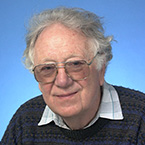
“What people need to understand about scientists is that their work is their reward. If you enjoy the science, you have something to look forward to every day.”
Oliver Smithies, DPhil, Fellow of the AACR Academy and the Weatherspoon eminent distinguished professor of pathology and laboratory medicine at the University of North Carolina School of Medicine, Chapel Hill, died Jan. 10, 2017, at the age of 91.
Smithies was awarded the Nobel Prize in Physiology or Medicine in 2007 for his discovery of the technique of homologous recombination of transgenic DNA with genomic DNA, the process known as “gene targeting”. Smithies ‘s technique of gene targeting made it possible to substitute functional genes for nonfunctional ones. Gene targeting was later used to “knock out” a gene in an experimental animal, thereby creating knockout mice to study specific genes. Gene targeting is commonplace now in biomedical research and is the basis for thousands of published reports.
Smithies shared the Nobel Prize with Mario R. Capecchi, PhD, FAACR, and Sir Martin J. Evans, PhD, FAACR, for their discoveries of principles for introducing specific gene modifications in mice by the use of embryonic stem cells.
A self-described “craftsman” and “tool-maker,” Smithies is also credited with the invention of starch gel electrophoresis in the early 1950s, which was a major advance over the methods of protein separation available at the time.
Smithies and his fraternal twin, Roger, were born June 23, 1925, in Halifax, England. Smithies received his bachelor ‘s and doctoral degrees from Oxford University and completed a fellowship in the United States at the University of Wisconsin. In 1954, Smithies joined the University of Toronto as a research chemist before returning to the University of Wisconsin in 1960, where he worked until he joined the faculty at the University of North Carolina in 1988.
The AACR inducted Smithies into the inaugural class of Fellows of the AACR in 2013. In addition, Smithies was recognized with myriad other honors throughout his career, including the Albert Lasker Award for Basic Medical Research, Wolf Prize in Medicine, Canada Gairdner International Award (twice), March of Dimes Prize in Developmental Biology, the O. Max Gardner Award from the University of North Carolina, the North Carolina Award for Science, and the Thomas Hunt Morgan Medal for Lifetime Contributions from the Genetics Society of America. He was elected to the U.S. National Academy of Medicine, U.S. National Academy of Sciences, the American Association for the Advancement of Science, and the Royal Society of London, and was a past president of the Genetics Society of America.
Career Highlights
2008 Thomas Hunt Morgan Medal for Lifetime Contributions, Genetics Society of America
2007 Nobel Prize in Physiology or Medicine
2005 March of Dimes Prize in Developmental Biology
2003 Wolf Prize in Medicine
2003 Elected to the Institute of Medicine
2002 O. Max Gardner Award, University of North Carolina
2001 Albert Lasker Award for Basic Medical Research
1998 Elected Foreign Member, Royal Society, London
1993 Gairdner Foundation International Award
1993 North Carolina Award for Science
1986 Elected Fellow, American Association for the Advancement of Science
1975 President, Genetics Society of America
1971 Elected Member, National Academy of Sciences, Washington, D.C.
1952 D.Phil., Balliol College, Oxford, UK